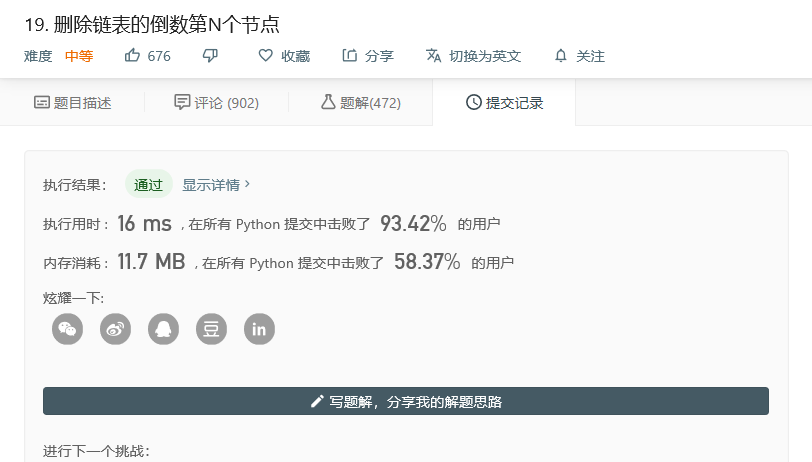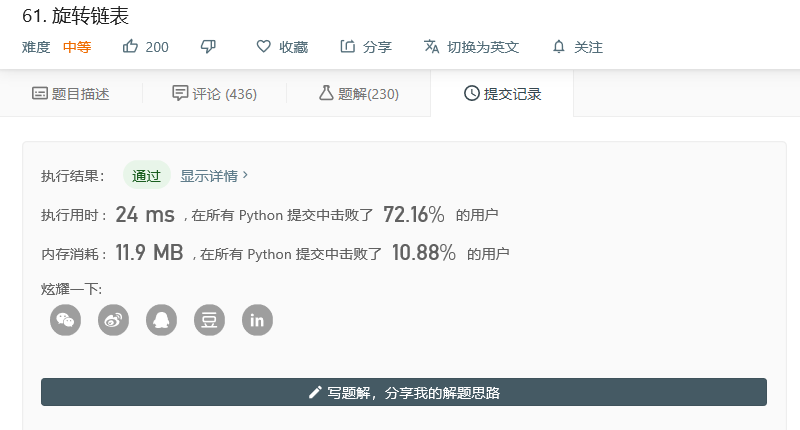Special topic of linked list: Leetcode 19 delete the last N nodes of the linked list + Leetcode 24 exchange the nodes in the linked list in pairs + Leetcode 61 rotate the linked list
Leetcode 19 delete the penultimate node of the linked list
Title Description
Given a linked list, delete the nth last node of the list and return the head node of the list.
Example:
Given a list: 1 - > 2 - > 3 - > 4 - > 5, and n = 2 When the penultimate node is deleted, the list changes to 1 - > 2 - > 3 - > 5
Explain:
The given n guarantee is valid.
Advance:
Can you try a scan implementation?
Title Solution
Since we want to pursue stimulation, we should carry it out to the end: directly meet this advanced request.
We need two nodes: = = one starting from the head node; one starting from the head node + N nodes. ==Then when the second node reaches the end, the next node of the head node is the location to be deleted. Then add the discussion of whether the deletion position is the boundary point to solve this problem easily:
The boundary points are as follows:
- When the deleted node is the head node
- The deleted node is the end node
The whole function is like this:
class Solution(object): def removeNthFromEnd(self, head, n): front = head second = None count = 0 flag = 0 while front: if front.next: front = front.next count = count + 1 if count > n-1: if flag == 0: second = head flag = 1 else: second = second.next else: break if second == None: res = head.next head = None return res else: if second.next: temp = second.next.next second.next = temp temp = None else: second.next = None return head
Operation result
Running time: 16 ms
Memory consumption: 11.7 MB

Leetcode 24 nodes in two exchange linked list
Title Description
Given a linked list, two pairs exchange the adjacent nodes and return the linked list after exchange.
You can't just change the internal values of nodes, but you need to actually exchange nodes.
Example:
Given 1 - > 2 - > 3 - > 4, you should return 2 - > 1 - > 4 - > 3
Title Solution
There is no special way, that is, to traverse from the beginning to the end and exchange the two. If there is only one node or there is no subsequent node, exit the traverse. The whole process is as follows:
class Solution(object): def swapPairs(self, head): if not head: return head cur1 = head cur2 = head.next if not cur2: return head while True: if cur1 == head: cur1.next = cur2.next cur2.next = cur1 head = cur2 else: if not cur1.next: break else: if not cur1.next.next: break else: temp1 = cur1.next temp2 = cur1.next.next temp1.next = temp2.next cur1.next = temp2 temp2.next = temp1 cur1 = temp1 return head
Operation result

Leetcode 61 rotating list
Title Description
Given a list, rotate the list, and move each node of the list to the right by K positions, where k is a non negative number.
Example 1:
Input: 1 - > 2 - > 3 - > 4 - > 5 - > null, k = 2 Output: 4 - > 5 - > 1 - > 2 - > 3 - > null Interpretation: Rotate 1 step to the right: 5 - > 1 - > 2 - > 3 - > 4 - > null Rotate 2 steps to the right: 4 - > 5 - > 1 - > 2 - > 3 - > null
Example 2:
Input: 0 - > 1 - > 2 - > null, k = 4 Output: 2 - > 0 - > 1 - > null Interpretation: Rotate 1 step to the right: 2 - > 0 - > 1 - > null Rotate 2 steps to the right: 1 - > 2 - > 0 - > null Rotate 3 steps to the right: 0 - > 1 - > 2 - > null Rotate 4 steps to the right: 2 - > 0 - > 1 - > null
Title Solution
In fact, he doesn't have to be obedient. If he can find the length of the whole list, he only needs to move K mod len(list) k \ text {mod} len(list) k mod len(list).
First, connect the head and tail of the list to form a ring (the length of the chain can be calculated when connecting), then start from the node at the beginning, and go to the steps of len(list) - (k \ text {mod} len(list)) len(list) - (k \ text {mod} len(list)) len(list) - (k \ mod len(list)). This point is our new head node. Disconnect from here and output this node After the chain, so the previous has been connected to the end of the list.
The code is as follows:
class Solution(object): def rotateRight(self, head, k): if (not head) | (k == 0): return head elif not head.next: return head cur = head length = 1 while cur.next: cur = cur.next length = length + 1 cur.next = head k = k % length if k == 0: cur.next = None return head cur = head for i in range(1, length - k): cur = cur.next head = cur.next cur.next = None return head
Operation result
Execution time: 24 ms
Memory consumption: 11.9 MB


